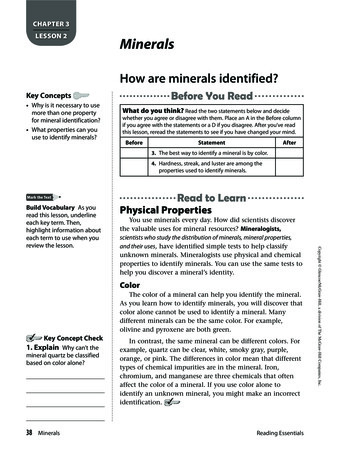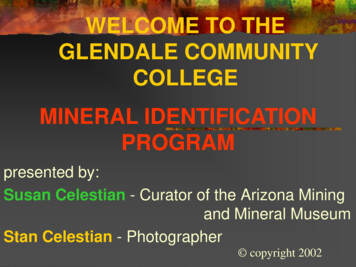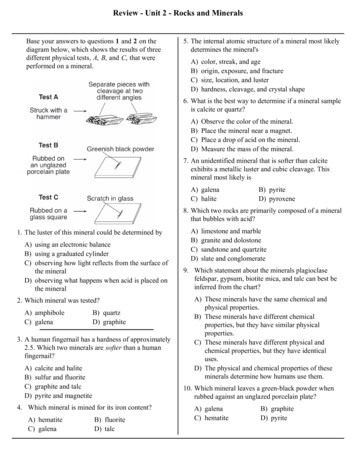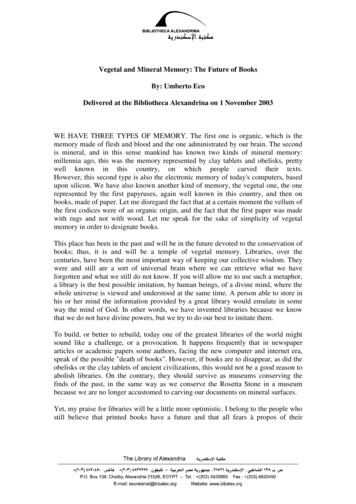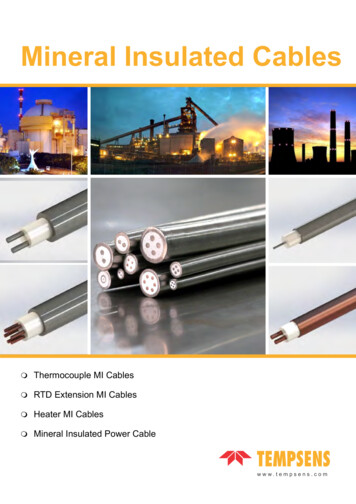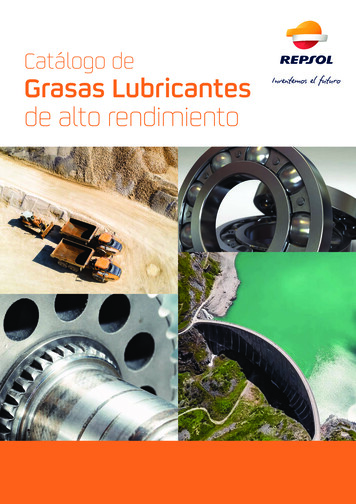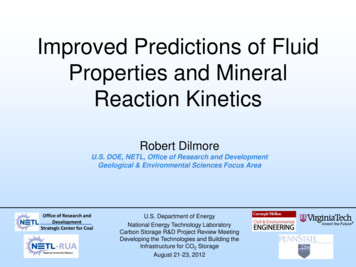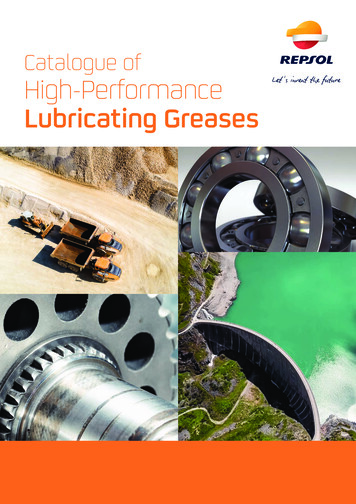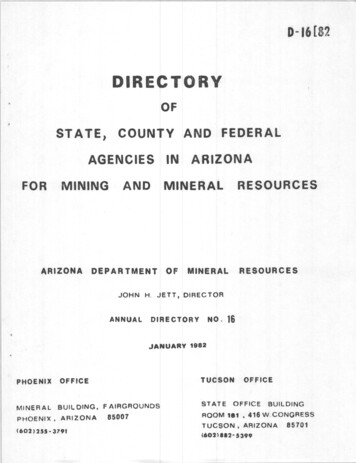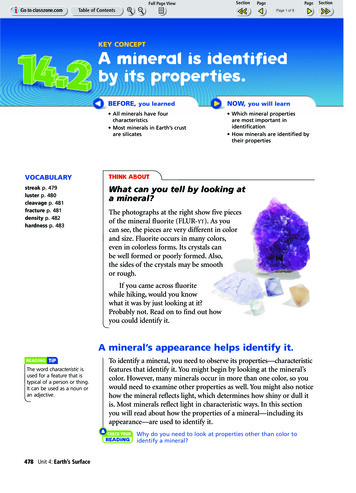
Transcription
Page 1 of 8KEY CONCEPTA mineral is identifiedby its properties.BEFORE, you learnedNOW, you will learn All minerals have fourcharacteristics Most minerals in Earth’s crustare silicates Which mineral propertiesare most important inidentification How minerals are identified bytheir propertiesVOCABULARYTHINK ABOUTstreak p. 479luster p. 480cleavage p. 481fracture p. 481density p. 482hardness p. 483What can you tell by looking ata mineral?The photographs at the right show five piecesof the mineral fluorite (FLUR-YT). As youcan see, the pieces are very different in colorand size. Fluorite occurs in many colors,even in colorless forms. Its crystals canbe well formed or poorly formed. Also,the sides of the crystals may be smoothor rough.If you came across fluoritewhile hiking, would you knowwhat it was by just looking at it?Probably not. Read on to find out howyou could identify it.A mineral’s appearance helps identify it.reading tipThe word characteristic isused for a feature that istypical of a person or thing.It can be used as a noun oran adjective.To identify a mineral, you need to observe its properties—characteristicfeatures that identify it. You might begin by looking at the mineral’scolor. However, many minerals occur in more than one color, so youwould need to examine other properties as well. You might also noticehow the mineral reflects light, which determines how shiny or dull itis. Most minerals reflect light in characteristic ways. In this sectionyou will read about how the properties of a mineral—including itsappearance—are used to identify it.check your reading478 Unit 4: Earth’s SurfaceWhy do you need to look at properties other than color toidentify a mineral?
Page 2 of 8Color and StreakSome minerals can be almost any color, but most minerals have amore limited color range. For example, a particular mineral mayalmost always be brown to black.Three main factors cause minerals to vary in color. First, a mineralmay get its color from tiny amounts of an element that is not part ofits normal chemical makeup. For example, a sample of pure quartzis clear and colorless, but tiny amounts of iron can give quartz aviolet color. This violet variety of quartz is called amethyst. Second,a mineral’s color can change when it is at or near Earth’s surface andis in contact with the atmosphere or water. Third, mineral crystalscan have defects in their crystal structures that change their color.Some minerals have a different color when they are ground into afine powder than when they are left whole. A mineral’s streak is thecolor of the powder left behind when the mineral is scraped across asurface. Geologists use a tile of unglazed porcelain, called a streak plate,as a tool to identify minerals by their streaks. Streak is a better clue toa mineral’s identity than surface color is. Look at the photographs ofhematite below. Even though the mineral samples are different colors,both leave a reddish brown streak when scraped across a streak plate.All samples of the same mineral have the same streak.check your readingreading tipA geologist is a scientistwho studies Earth.What is the difference between color and streak?StreakThese samples are of the mineral hematite. They aredifferent colors, but they have the same streak.This hematite looks dull because ithas tiny crystals that reflect lightin all directions.This hematite looks shiny becauseit has larger crystals.What is a clue that both samples are of the same mineral?Chapter 14: Minerals 479
Page 3 of 8reading tipLuster comes from theLatin lu–stra–re, “to makebright.” But luster isn’talways bright or shiny.Some minerals have lustersthat are waxlike or dull.LusterA mineral’s luster is the way in which light reflects from its surface.The two major types of luster are metallic and nonmetallic. Themineral pyrite has a metallic luster. It looks as if it were made ofmetal. A mineral with a nonmetallic luster can be shiny, but it doesnot appear to be made of metal. An example of a nonmetallic lusteris the glassy luster of garnet. Compare the lusters of pyrite and garnetin the photographs below.Pyrite has a metallic luster.Garnet crystals in this rockhave a nonmetallic luster.Like a mineral’s color, its luster may vary from sample to sample.If a mineral has been exposed to the atmosphere or to water, its surface luster can become dull. However, if the mineral is broken toreveal a fresh surface, its characteristic luster can be seen.The way a mineral breaks helps identify it.SUPPORTING MAIN IDEASEnter this blue headingin a chart and recordsupporting information.If you hit a piece of calcite with a hammer, the calcite will break intotilted blocks. You can peel off layers of mica because it splits into thin,flat sheets. Each kind of mineral always breaks in the same way, andthis property can help identify a mineral. In fact, the way a mineralbreaks is a better clue to its identity than are its color and luster.CleavageCleavage is a tendency to break along flat surfaces.Calcite has cleavage.480 Unit 4: Earth’s SurfaceIt breaks along flat surfaces because thebonds between its atoms are less strongin some directions than in others.
Page 4 of 8Cleavageis the tendency of a mineral to breakalong flat surfaces. The way in which a mineralbreaks depends on how its atoms are bonded, orjoined together. In a mineral that displays cleavage,the bonds of the crystal structure are weaker in thedirections in which the mineral breaks.CleavageCarbon Bonds in Graphitestrong bondswithin layersweak bondsbetween layersWhen geologists describe the cleavage of a mincarbon atomseral, they consider both the directions in which theIn graphite, carbon atoms are arranged inmineral breaks and the smoothness of the brokenlayers. Graphite has cleavage because thesurfaces. Mica has cleavage in one direction andweak bonds between the layers break easily.breaks into sheets. The photographs on page 480show that calcite has cleavage in three directions and breaks into tiltedblocks. Because the broken surfaces of both mica and calcite aresmooth, these minerals are said to have perfect cleavage.FractureFracture is the tendency of a mineral to break into irregular pieces.Some minerals such as quartz break into pieces with curved surfaces,as shown below. Other minerals may break differently—perhaps intosplinters or into rough or jagged pieces.VOCABULARYAdd a descriptionwheel for fracture inyour notebook.In a mineral that displays fracture, the bonds that join the atomsare fairly equal in strength in all directions. The mineral does notbreak along flat surfaces because there are no particular directions ofweakness in its crystal structure.check your readingHow does the strength of the bonds between atoms determinewhether a mineral displays cleavage or fracture?FractureFracture is a tendency to break into irregular pieces.Quartz does not have cleavage.It breaks by fracturing.It breaks along irregular surfaces becausethe bonds between its atoms are aboutthe same strength in every direction.Chapter 14: Minerals 481
Page 5 of 8A mineral’s density and hardness helpidentify it.A tennis ball is not as heavy or as hard as a baseball. You would beable to tell the two apart even with your eyes closed by how heavy andhard they feel. You can identify minerals in a similar way.reading tipThe unit of density is gramsper cubic centimeter and isabbreviated as g/cm3.DensityEven though a baseball and a tennis ball are about the same size, thebaseball has more mass and so is more dense. A substance’s densityis the amount of mass in a given volume of the substance. For example, 1 cubic centimeter of the mineral pyrite has a mass of 5.1 grams,so pyrite’s density is 5.1 grams per cubic centimeter.Density is very helpful in identifying minerals. For example, goldand pyrite look very similar. Pyrite is often called fool’s gold. However,you can tell the two minerals apart by comparing their densities. Goldis much denser than pyrite. The mass of a piece of gold is almost fourtimes the mass of a piece of pyrite of the same size. A small amountof a very dense mineral, such as gold, can have more mass and beheavier than a larger amount of a less dense mineral, such as pyrite.A mineral’s density is determined by the kinds of atoms that make upComparing DensitiesDifferences in density can be used to tell minerals apart.quartzThe baseball on the right has more mass,and so is denser, than a tennis ball that isabout the same size.The zincite sample on the right is abouttwice as dense as the quartz sample.Estimate the size a piece of quartz would have to be to balance thezincite sample.482 Unit 4: Earth’s Surfacezincite
Page 6 of 8the mineral, as well as how closely the atoms are joined together. Anexperienced geologist can estimate the density of a mineral by lifting it.But to get an exact measurement, geologists use special scales.check your readingWhy does a piece of gold weigh much more than a piece ofpyrite that is the same size?HardnessOne way to tell a tennis ball from a baseballwithout looking at them is to compare theirdensities. Another way is to test which one isharder. Hardness is another dependable clue toa mineral’s identity.A mineral’s hardness is its resistance to beingscratched. Like a mineral’s cleavage, a mineral’shardness is determined by its crystal structureand the strength of the bonds between its atoms.Harder minerals have stronger bonds.A scale known as the Mohs scale is oftenused to describe a mineral’s hardness. This scaleis based on the fact that a harder mineral willscratch a softer one. As you can see in the chart atthe right, ten minerals are numbered in the scale,from softest to hardest. Talc is the softest mineraland has a value of 1. Diamond, the hardest of allminerals, has a value of 10.A mineral can be scratched only by otherminerals that have the same hardness or areharder. To determine the hardness of anunknown mineral, you test whether it scratchesor is scratched by the minerals in the scale. Forexample, if you can scratch an unknown mineralwith apatite but not with fluorite, the mineral’shardness is between 4 and 5 in the Mohs scale.In place of minerals, you can use your fingernail, a copper penny, and a steel file to test anunknown mineral. To avoid damage to theminerals, you can test whether the mineralscratches these items. When using a penny to testhardness, make sure its date is 1982 or earlier.Only older pennies are made mainly of copper,which has a hardness of about 3.Mohs Scale1Talcgypsum2Gypsum3Your fingernail has ahardness of about 2.5, soit can scratch gypsum.Calcite4Fluorite5Apatite6FeldsparapatiteA steel file has a hardnessof about 6.5. You canscratch apatite with it.7Quartz8Topaz9CorundumDiamond is the hardestmineral. Only a diamondcan scratch anotherdiamond.10DiamonddiamondChapter 14: Minerals 483
Page 7 of 8Hardness of MineralsHow hard are some common minerals?SKILL FOCUSClassifyingPROCEDURE1Try to scratch each mineral with your fingernail, the penny, and thesteel file. Record the results in a chart.2 Assign a hardness range to each mineral.3 In the last column of your chart, rank the minerals from hardestto softest.WHAT DO YOU THINK? Use your results to assign a hardness range in the Mohs scale to each sample.MATERIALS samples of 5minerals copper penny(1982 or earlier) steel fileTIME20 minutes If two minerals have the same hardness range according to your tests,how could you tell which is harder?CHALLENGE If you had a mineral that could not bescratched by the steel file, what else might youtest it with to estimate its hardness?Some minerals have special properties.The photographs on page 485 show how geologists test some minerals.Such tests help them identify minerals that have unusual properties.Minerals in the carbonate group, such as calcite, react with acid.Chalk is a familiar item that is made up of carbonate minerals. Thetest consists of putting a drop of a weak solution of hydrochloricacid on a mineral sample. If the acid reacts with the mineral, carbondioxide gas will form and bubble out of the acid. The bubbles showthat the mineral is a carbonate.Some minerals have a property known as fluorescence(flu-REHS-uhns). Fluorescent minerals glow when they are exposedto ultraviolet (UHL-truh-VY-uh-liht) light. The word fluorescencecomes from the name of the mineral fluorite, which has this property.Other minerals that display fluorescence include calcite and willemite.Although fluorescence is an interesting and sometimes dramaticproperty, it has limited value in mineral identification. Differentsamples of the same mineral may or may not display fluorescence,and they may glow in different colors.check your reading484 Unit 4: Earth’s SurfaceTo identify calcite, why would it be more useful to test withdilute hydrochloric acid than to check for fluorescence?
Page 8 of 8Special PropertiesFluorescenceAcid Testnormal lightultraviolet lightThese minerals look ordinary in normal light but display redand green fluorescence under ultraviolet light.Acid in contact with carbonateminerals, such as calcite, forms bubbles.A few minerals respond to magnets. A magnet is pulled towardthese minerals. The mineral magnetite strongly attracts magnets, andsome other minerals weakly attract magnets. To test a mineral, hold amagnet loosely and bring it close to the mineral. You will be able tonotice if there is even a small pull of the magnet toward the mineral.Magnets are commonly used in laboratories and industries to separatemagnetic minerals from other minerals.Some rare minerals have a property known as radioactivity. Theycontain unstable elements that change into other elements over time.As this happens, they release energy. Geologists can measure this energyand use it to identify minerals that contain unstable elements.KEY CONCEPTSCRITICAL THINKING1. Why is color not a reliable clueto the identity of a mineral?4. Analyze Which mineralidentification tests wouldbe easy for a person toperform at home? Whichwould be difficult?2. What is the difference betweencleavage and fracture?3. Describe what would happenif you rubbed a mineral witha Mohs hardness value of 7against a mineral with a valueof 5.5. Draw Conclusions Diamondand graphite contain onlycarbon atoms. How can youtell which mineral’s atomsare bonded more closely?CHALLENGE6. Apply The mineral topaz hasperfect cleavage in one direction. It also displays fracture.Explain why a mineral such astopaz can display both cleavage and fracture.Chapter 14: Minerals 485
A mineral's is the way in which light reflects from its surface. The two major types of luster are metallic and nonmetallic. The mineral pyrite has a metallic luster. It looks as if it were made of metal. A mineral with a nonmetallic luster can be shiny, but it does not appear to be made of metal. An example of a nonmetallic luster
